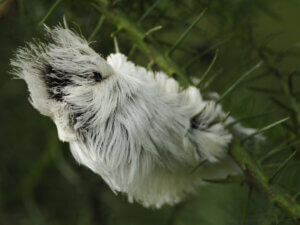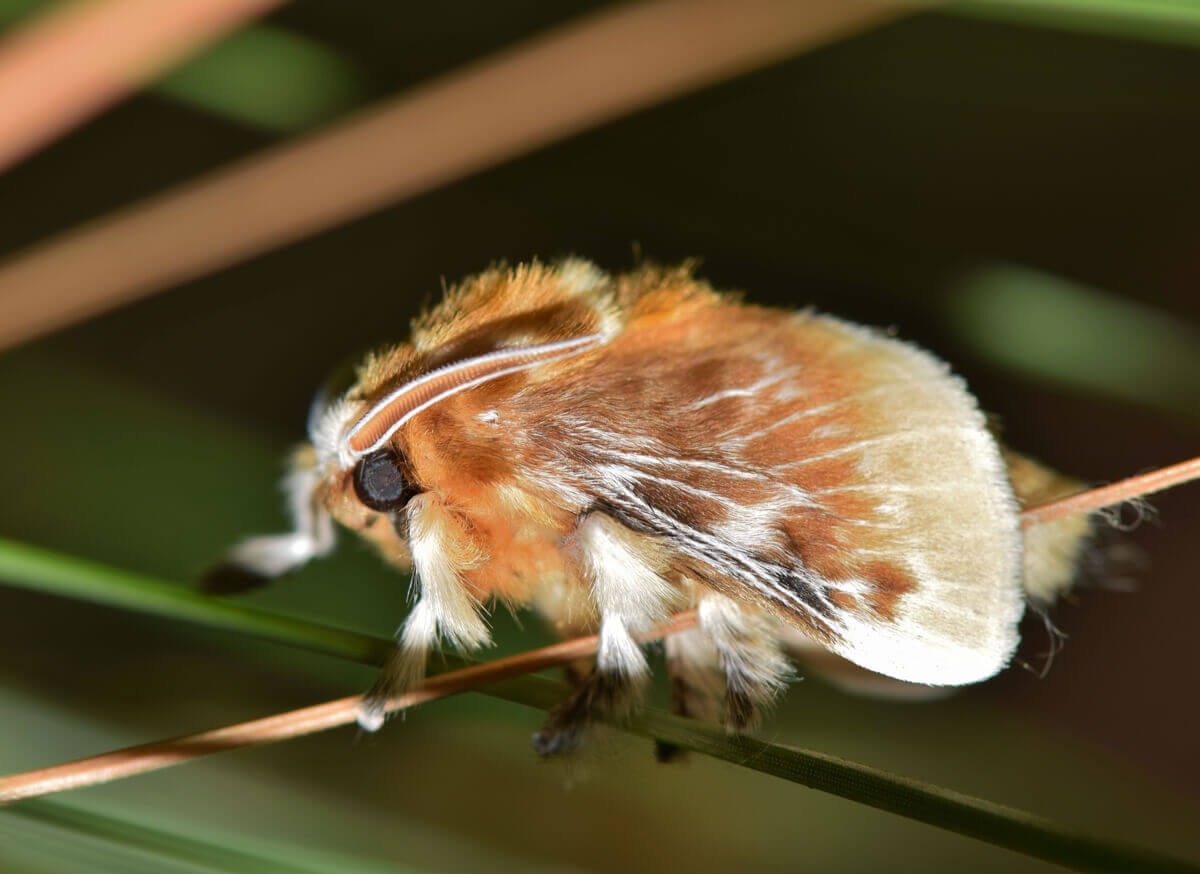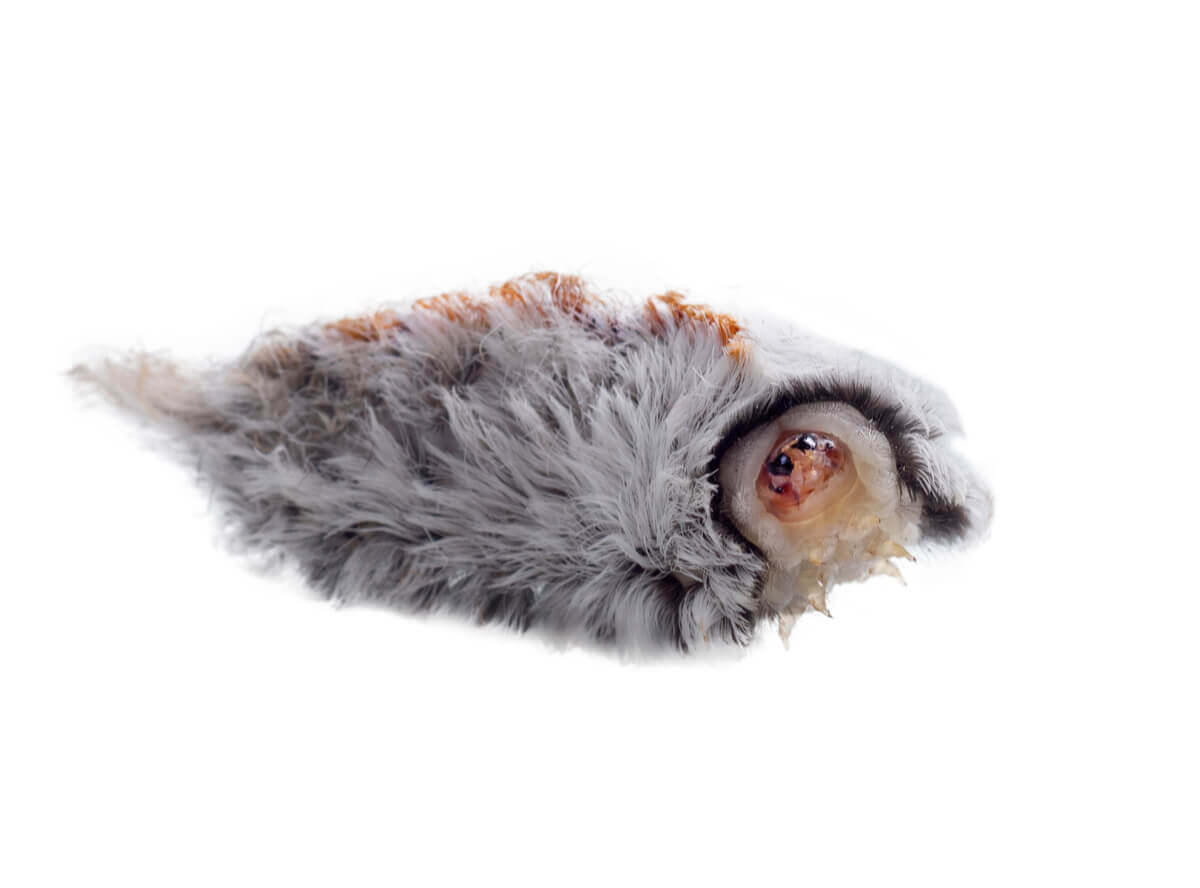The Southern Flannel Moth: Rare, Beautiful, and Dangerous

The southern flannel moth (Megalopyge opercularis) is a moth from the Megalopygidae family. It goes by many other names, including the puss caterpillar, asp, Italian asp, woolly slug, opossum bug, puss moth, tree asp, or asp caterpillar.
This caterpillar is often prolific in its region of origin and can infest shady trees and shrubs around houses, schools, and parks. From trees, these dangerous invertebrates fall on victims and can cause multiple stings. If you want to know more about this lethal but fascinating lepidoptera, read on.
How to recognize the southern flannel moth?
Below, we’ll present a series of characteristic features of this animal:
- The caterpillars of the southern flannel moth are teardrop-shaped and have long, silky hairs. This is why this larva can give the impression of a tuft of cotton or the shiny coat of a Persian cat.
- Its color varies from yellow-gray to reddish-brown or a mixture of shades.
- The mature larva is around 0.5 inches long with seven pairs of sucker-like closures on the rear half of the body.
- The adult moth has blunt wings covered with long, wavy hair and a wingspan of 1 to 1.2 inches. The wings are orange at the base, cream-colored at the tips, and the legs are covered with delicate, brightly colored hairs.
Life history of the southern flannel moth
The scientific name of the southern flannel moth is Megalopyge opercularis. Adult moths emerge in late spring or early summer and lay hundreds of eggs on trees such as oak, walnut, elm, almond and other shady trees.
It’s important to note that one or two generations occur each year, although caterpillars tend to be more common in the autumn. During the winter, the cat caterpillar remains as a cocoon on the trunk or branches of the host plant.

The southern flannel moth caterpillar is beautiful and poisonous
It’s important to note that caterpillars and all life stages of the southern flannel moth can pose a danger to human health. The southern flannel moth caterpillar has developed exceptional defense practices against predators.
Thus, their strategies include defensive mimicry and the production of proteolytic, neurotoxic, and allergenic toxins. For this reason, when our skin comes into contact with the caterpillar’s hairs, we experience intense, stabbing pain.
Commonly, if the contact takes place on the arm, the toxins can cause pain in the axillary region. In addition, erythematous spots may appear at the area of the sting on the patient. Other symptoms include headaches, nausea, vomiting, lymphadenopathy, lymphadenitis, and sometimes shock or respiratory stress.
First aid for southern flannel moth poisoning
It’s important to know that southern flannel moth contact poisoning always requires medical attention, hospitalization, and even treatment in an emergency care unit. First, you should apply an ice pack should to the area of the sting. What’s more, the patient may receive oral antihistamines to help relieve the itching and burning sensations.
In addition, experts recommend applying adhesive tape to the sting and then carefully removing it. This can help eliminate irritating stingers. Eye injuries require immediate medical attention.

Control of the moth population
The moth can be controlled when they become abundant by spraying the environment with a residual pesticide. This is the case with permethrin, cyfluthrin, or similar aerosols labeled for caterpillar control on ornamental plants.
In some cases – such as in school playgrounds – the best solution may be to educate students and teachers about what caterpillars are and the importance of not touching them with their bare hands. Without a doubt, the best prevention is completely avoiding contact with this invertebrate.
All cited sources were thoroughly reviewed by our team to ensure their quality, reliability, currency, and validity. The bibliography of this article was considered reliable and of academic or scientific accuracy.
- Hall,D.W. (2012, revised 2019). Puss caterpillar (larva), southern flannel moth (adult). in Featured Creatures. Entomology and Nematology. Publication Number: EENY-464. University of Florida. http://entnemdept.ufl.edu/Creatures/MISC/MOTHS/puss.htm
- McGovern JP, Barkin GD, McElhenney TR, Wende R. (1961). Megalopyge opercularis: observations of its life history, natural history of its sting in man, and report of an epidemic. Journal of the American Medical Association 175(13): 1155-1158
- Avilán, L., Guerrero, B., Álvarez, E., & Rodríguez-Acosta, A. (2010). Description of envenomation by the “gusano-pollo” caterpillar (Megalopyge opercularis) in Venezuela. Investigación clínica, 51(1), 127-132.
- Forrester, M. B. (2018). Megalopyge opercularis caterpillar stings reported to Texas Poison Centers. Wilderness & Environmental Medicine, 29(2), 215-220.
This text is provided for informational purposes only and does not replace consultation with a professional. If in doubt, consult your specialist.